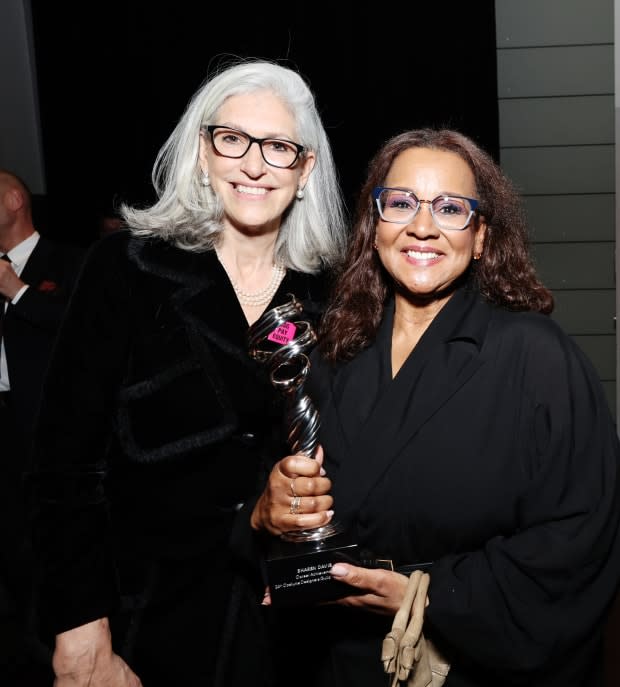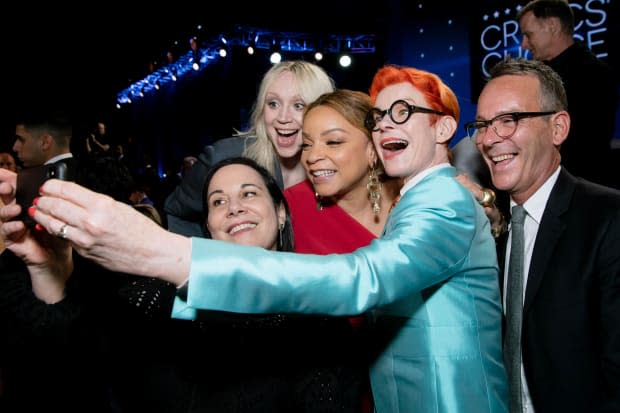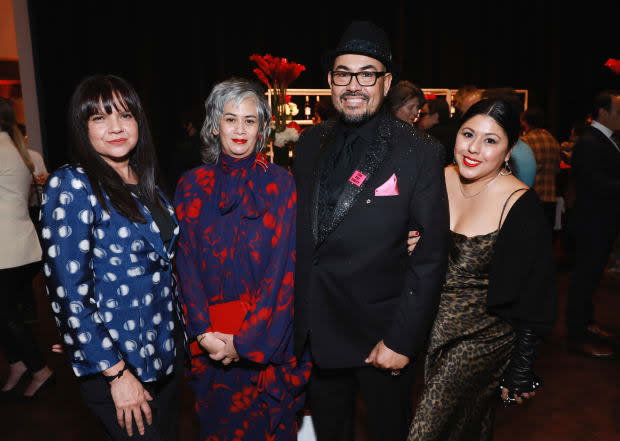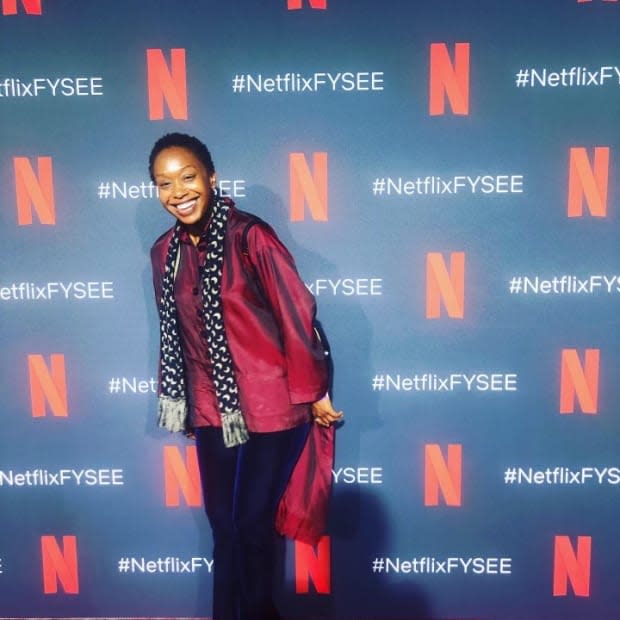The Real Reason Costume Designers Are Paid Less Than Their Peers
- Oops!Something went wrong.Please try again later.
And why A-list actors and directors are helping them fight for change.
"Personally, I wouldn't even know how to start inhabiting the character without the initial costume fitting," Elle Fanning said in a recent Instagram video. She's one of several A-list actors and directors — along with Jean Smart, Sofia Coppola, Judd Appatow and Helen Mirren — who took part in a Costume Designers Guild (CDG) grassroots campaign supporting pay equity and creating awareness about the wage gap between costume teams and their production counterparts.
In her testimonial, Fanning lauded her frequent collaborator Mirren Gordon Crozier for helping her take on the challenge of portraying "real life person" Michelle Carter in "The Girl From Plainville." "Without Mirren's detailed eye, I know I would never ever have been able to play the part the way I needed to," she said. (The actor is already receiving award-season buzz for her performance in the Hulu limited series, as well as for her comedic work in the second season of "The Great," costume designed by CDG Award winner Sharon Long.)
View the original article to see embedded media.
"I always say, 'the camera frame is the actor, costumes, hair and makeup,'" explains Imani Akbar, costume designer for the Showtime comedy "I Love That For You," on a call with Fashionista.
These crucial creative leads — along with production designers (a.k.a. art directors), cinematographers (or directors of photography) and essential craft services — collaborate to create impactful and memorable images that comfort, entertain and inspire us. Like hair and makeup artists, costume designers play the most intimate parts in on-screen storytelling, and the hours are long, grueling and unpredictable. Like, if a guest star is cast on a Sunday to film on Monday, guess who has to drop everything in their already-stretched-thin lives and scramble to source, maybe even build and fit what they're going to wear?
Yet per the CDG, the current weekly scale wage (based on a 60-hour work week, mind you) shows television costume designers starting at $2,952 and film costume designers at $3,140. In comparison, makeup department heads get $4,576, production designers $4,103 and directors of photography $8,374. (Craft service sits in between both costume design jobs at $3,015.)
Taking a step back, here's some background on how these kinds of things are negotiated: As many learned during the IATSE (International Alliance of Theatrical Stage Employees, pronounced "eye-ah-tsee") negotiations and averted strike last year, entertainment workers behind the camera — or "below the line," in industry speak — belong in local labor unions speaking to their specialty. The CDG is otherwise known as Local 892, while hair and makeup artists work in Local 706. Along with 12 other West Coast local chapters, Local 892 falls under the IATSE umbrella of "collective bargaining," meaning all 13 unions have to agree on the terms before going in for their negotiations with the Alliance of Motion Picture and Television Producers (AMPTP), which is made up of big studio powerbrokers like Disney, Paramount and Universal. The negotiations happen every three years; the next will be in 2024.
The IATSE was formed back in the live-theater-only days of 1893. The CDG didn't join until 1976 — and with less-than-ideal contract terms for base wages. Back then, the pay gap between costume and production designers was $357 per week. Fast forward over 45 years (with 3% raises each year to adjust for inflation), the disparity is still glaring at $963 per week in 2021. Why is that? It's not too hard to figure out.
"I would lay awake at night staring at the ceiling, and I only came to one conclusion because there was only one conclusion to be had. It was the obvious one, the elephant in the room," says Dr. Deborah Nadoolman Landis, founding director and chair of the David C. Copley Center for Costume Design at the UCLA School of Theater, Film & Television. "It's because we're women, and women aren't seen or acknowledged. And that was it."

Photo: Amy Sussman/Getty Images for CDGA
According to the CDG, nearly 85% of costume designers are women, but they make 30% less per week than their fellow production designers (in the Art Directors Guild, Local 800). Production design is a much more male-dominated field. As "WandaVision" Emmy winner Mayes Rubeo told Variety: "Production designers and costume designers are two halves of one whole, and we should be paid equally."
Dr. Landis discovered systemic sexism in the industry while earning her doctorate in the history of design from the Royal College of Art in London. The Oscar nominee (for Eddie Murphy's 1988 classic "Coming to America") then returned to Hollywood to serve two terms as president of the CDG, from 2001 to 2007. In 2002, she presented this ongoing issue with a Powerpoint presentation — still preserved in her laptop files — to fellow IATSE board members and studio labor reps.
"That's twenty years ago," she emphasizes.
Essentially giving a "101" to visually demonstrate the value of costume design in the filmmaking process, Dr. Landis opened with "12 Unforgettable Costumes:" Marilyn Monroe's white subway grate dress by William Travilla in "The Seven Year Itch," Dorothy's blue gingham ensemble by Gilbert Adrian in "Wizard of Oz," Harrison Ford's rugged adventurer look from "Indiana Jones and the Raiders of the Lost Ark" (which Dr. Landis herself designed). They inspired fashion trends, future storytelling (see: "Zola"), even cosplay and merchandising — for which designers are rarely compensated.
"And they all laughed," says Dr. Landis. "They thought I was terribly amusing."

Photo by Emma McIntyre/Getty Images
Triple Oscar nominee Arianne Phillips, the go-to costume designer for the likes of Tom Ford and Madonna, recalls being one of the few behind-the-camera folks in early Time's Up meetings. "We're invisible because we're 'below-the-line,' which is an antiquated construct about how the film industry works," she says.
Phillips is a member of the CDG Pay Equity Committee. Like her colleagues, she felt inspired and motivated through the social justice movements across the nation and by watching the U.S. Women's national soccer team fight for pay equity, which resulted in a winning $24 million settlement in February 2022. The "culture shift" created an optimal opportunity to ramp up the CDG's pay equity efforts and bring the discussion to the forefront.
"Everything has just magnified these gross inequities in our culture, and whether it's gender or race, or feeling safe or seen or heard," says Phillips. "It's this groundswell of these patriarchal and antiquated constructs."
There's also work to be done within the costume-design community itself by breaking a longtime taboo: discussing pay openly.
"Producers made these rules: 'You shouldn't talk about your rate,''' says current CDG President (and Mindy Kaling's longtime costume designer) Salvador Perez.
By discouraging salary transparency, they prevent costume designers from knowing — and asking to be paid — what they're worth. Plus, productions usually employ just one head costume designer, who's then isolated from spontaneous money discussions with peers.
Pay has "always been one of those things that you're told not to talk about," concurs "The Sex Lives of College Girls" costume designer Glinda Suarez. But "the guild is really pushing and asking what we're making, like, 'Don't be embarrassed. You really are hurting yourself by not talking about rates.'"
To encourage transparency amongst each other, the CDG asks members to pass their contracts through its main office, to check the fine print and provide guidance on negotiations. These efforts also help build a crucial database of salaries and rates, which serve as reference and leverage points. "We're seeing a 30% increase in rates of people who are actively discussing their rate," says Perez.
Head costume designers usually have agents to help negotiate contracts, but they should also advocate for and be transparent with their junior teams. "As an assistant designer, you have to go up to bat for yourself," says Suarez, who worked under Perez on earlier seasons of "Never Have I Ever" and moved up to head costume designer for the upcoming season three. She credits past bosses and CDG Executive Director Brigitta Romanov for openly discussing numbers and pushing her to ask for more: "I would email [Romanov] and I said, 'I got this, yay! I got a little bit more.' Just so she knows that it's working."

Photo: Matt Winkelmeyer/Getty Images for CDGA
Unsurprisingly, there are also racial inequities that need to be addressed. According to a recent study by the National Women’s Law Center (NWLC), in the U.S., Black, Native American and Latina women earn 58 cents, 50 cents and 49 cents, respectively, for every dollar a white, non-Hispanic man earns. (A white, non-hispanic woman makes 73 cents and an Asian American woman 75 cents on the dollar, compared to a white, non-Hispanic man.)
One hurdle in BIPOC costume designers getting their voices heard is the fact that there just aren't many of them. In a December 2021 poll with an 87% response rate, roughly 33% of CDG membership identify as BIPOC.
In the wake of the country's social justice reckoning following the murder of George Floyd in 2020, Hollywood studios (along with the fashion and beauty industries) announced new inclusion efforts. The CDG formed a Diversity Committee and launched a series of panels featuring BIPOC and LGBTQ+ designers. Alongside union efforts, individual senior costume designers began or continued to mentor and create opportunities for young designers from underrepresented communities.
"We have to bring [new people] into the industry, not only to become more inclusive and diverse, which is very important, but also to keep up with the demand for content," says Phillips. "We have to pipeline people in, and they're inheriting these antiquated systems that aren't reflective of where we are in our in our culture."

Photo: Courtesy of Imani Akbar
After starting her career as a costumer in Local 705, Akbar joined the CDG in 2013 as an assistant and jumped on her first head-of-department role in 2021. (Side note: Often conflated, costume designer and costumer are two different jobs with separate unions.) She has experienced the challenges of being a Black woman in Hollywood firsthand — the microaggressions, the unconscious (and conscious) biases, the preconceived notions that greet her upon job interviews and on set.
"I've actually had a producer say to me that I should be 'grateful' to be there," says Akbar. That was quite shocking to hear."
She also became part of the Diversity Committee, meeting with fellow designers and participating in the panels. "There definitely aren't enough Black and people of color that are working as costume designers," says Akbar, who's noticed a deceleration in the enthusiasm and advancement in diversity efforts, as the conversations abate and everyone goes back to their jobs, as in many industries. "If [the CDG had] the fervent energy that they have with pay equity for inclusion, that would help,"
Suarez, who's Mexican American, feels more encouraged about the outlook: "We still have a little bit of work to do, but it's getting better, and I'm seeing more and more designers of color and more Latinas designing. It's very refreshing. I feel as if there's nothing but positive that's gonna come out of this. I'm hoping."
To spread the word about pay disparity, Perez emphasizes the need for actors, directors and producers to publicly advocate on behalf of their costume designers _ "to say, 'Hey, my costume designer is valuable. Pay them their worth.' That's what this campaign is."
He's moved by the heartfelt personal anecdotes and gestures by recognizable bold names. During the video campaign rollout at the Oscars in March, "Cruella" costume designer Jenny Beavan accepted her award wearing a bespoke tux and blouse embroidered with the words "Naked Without Us" (pictured, top).
Importantly, the #NakedWithoutUs campaign illustrates the importance of costume designers in storytelling — and the pay inequity they face — to the influential fans paying for movie tickets, streaming content and posting on social media.
"The industry has to be shamed into it. This has to be argued in the court of public opinion," says Dr. Landis.
View the original article to see embedded media.
In his video, Barry Jenkins heaped praise on his longtime designer Caroline Eselin ("Underground Railroad," "If Beale Street Could Talk," "Moonlight"), as well as Jamie Catino and Liz Vastola.
"They're all women, and they're all underpaid commensurate to the other department heads on the shows that we've done," said the Oscar-winning writer and director. "I don't know why this is. I've just learned that and it's unacceptable."
Jenkins's sign-off drives home the point: "The shit must stop."
Never miss the latest fashion industry news. Sign up for the Fashionista daily newsletter.
